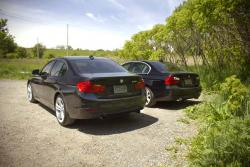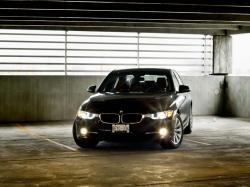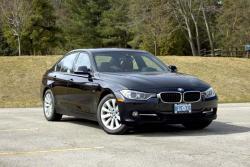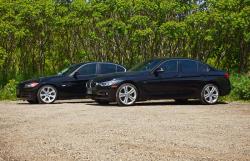 2013 BMW 335i vs 2008 BMW 335i. Click image to enlarge |
Review and Photos by Jeff Wilson
If you’re an automotive geek like most of us at Autos.ca, you probably refer to most German cars by their generational internal reference codes given by the manufacturers rather than the marketing names.
For instance, the 993 is the last of the air-cooled Porsche 911s. The B8 generation Audi S4 replaced the V8 with a supercharged V6. And of course everybody knows that the now classic W126 (S-Class) Mercedes was built like a tank. You get the idea.
This exceptionally advanced part of the car nerd’s brain enables him (or her) to show off the considerable time that must’ve been wasted learning all the codes, but also facilitates easier discussion with other car nerds.
BMW 3 Series aficionados toss around the marque’s development codes like a Trekkie speaks Klingon, and so for those who are uninitiated, let me give you a brief overview of the codes as they relate to our comparison; mostly to show off how learned I am, but also to help clarify for the review.
Our subject vehicles are BMW’s enduring and revered compact luxury sedans: the 3 Series. The current generation (2012–present) sedan is known as the F30. The previous generation (2006–2011, in Canada) sedan is known as the E90. The E92 is the coupe, E93 the convertible and E91 the wagon.
The media and Internet “experts” alike have wailed incessantly that the F30 3 Series is too big, too soft and too aloof compared to its predecessors, and that they’ve lost much of the passionate soul for which this line has become famous. Cries of BMW losing its way and abandoning the faithful, performance-hungry customers that have lusted after and purchased the nimble, high performance sedans for more than three decades are echoing through online forums around the world. Are these witch hunts founded? Let’s find out.
   2013 BMW 335i vs 2008 BMW 335i. Click image to enlarge |
Our current generation car is a black 335i. BMW Canada kindly provided us a 335i Sport with xDrive all-wheel drive and an eight-speed automatic – the most popular configuration for a new 335i, by the way. But our E90, also in black, is a 2008 335i with Sport Package, rear-wheel drive and a proper row-your-own six-speed manual. So the comparison isn’t really fair, which is why we also sought out an additional F30 335i Sport with a manual and rear-wheel drive.
Full disclosure, the E90 car is my personal daily driver and my third 3 Series BMW. It was purchased a few years ago as a Certified Pre-Owned car from a BMW dealership ensuring it had gone through BMW’s rigorous inspection before being sold and came with the all-important warranty to 160,000 km (or six years). Now approaching its six-year birthday, my car, with only 75,000 km on it, will run out of time long before warranty mileage.
When BMW revealed the E90 to the world in ’05, there was a collective gasp of relief that the Bangle-era styling exercise was a relatively tame application for the new 3 Series. That said, the E90 was still larger, heavier and more overtly styled than its predecessor, but most agreed that it still retained much of the BMW DNA as a legitimate sport sedan.
In 2007, the 335i was introduced with a twin-turbo version of the venerable 3.0L inline-six-cylinder engine, dubbed the N54 (more nerd codes for you). This engine, with its prairie-flat torque curve, feels much stronger than its 300 hp/300 lb-ft rating suggests.
Early N54-equipped cars tended to heat up under very brisk driving exercises and BMW quickly added an oil-cooler fix. Other well-documented problems for the N54 include faulty high-pressure fuel pumps and turbos that can be consumed at alarming rates. Fortunately my car has been relatively reliable so far, knock on wood.
For the 2011 model year, the N55 engine replaced the N54 and featured a single twin-scroll turbo instead of the twin-turbo configuration of the older mill. This resulted in fewer moving parts (and thus, arguably better reliability) and improved fuel consumption and emissions. Power and torque output remains the same, although peaks for each are delivered around 100 rpm lower in the newer engine. The N55 carries on into the F30 335i as found in our test cars.
Now that we’ve addressed all the techno mumbo-jumbo, what are these cars actually like to drive? Succinctly, both old and new, they’re fantastic.
The E90 was considered the entry-level luxury sport sedan benchmark throughout its entire lifecycle (as was its E46 forebear). By modern family sedan measure, this 3 Series is a compact and tidy design that keeps the car nimble enough to comfortably toss around on sinewy roads. And while 3 Series Bimmers have always been known for their perfect balance and 50/50 weight distribution, it’s the lively and exceptionally communicative steering that really helped set the BMW above the competition in most comparisons.
Five years of enjoyment hasn’t diminished the E90 test car’s playful-yet-precise on-road feel. As is typical of all German cars I’ve driven, the older BMW still possesses a heft and solidity not found in its Japanese counterparts. This hewn-from-a-block-of-granite feel also keeps the older car squeak and rattle free despite its aging bones.
The most common assault leveled against the F30 335i involves BMW’s decision to implement electric steering over the celebrated hydraulic setup used since the dawn of man. While the more modern application arguably saves a few microlitres of fuel, it does isolate the driver a bit more from what’s happening where the rubber meets the road.
When driven back to back, there is considerable truth to this. Indeed the newer car simply seems to remove a measure of immediacy and intimacy the driver has with the driving experience. The E90’s steering wheel quivers and buzzes and reacts to the slightest surface change beneath the Bridgestone run-flat tires, while there is a marginally greater disconnect in the F30’s steering. The effort required to turn the newer car’s steering wheel is notably less as well.
The handling remains a strong suit on the new car, and it charges just as hard into sweepers as the previous generation model. That said, I was always aware of the sensation that the F30 is a longer car than the E90 when transitioning from corner to corner.
It should be pointed out that the F30 remains one of the most enjoyable sport sedans that can be purchased, but only when comparing directly do the subtle differences show themselves, otherwise, the latest 3 Series is still unmistakably a 3 Series. The same xDrive-equipped 335i shown here was recently featured in an Autos.ca comparison test where it was barely squeezed out of the top spot by the more costly Audi S4. As noted in that comparison, the 3 Series might very well have been only a wheel-and-tire package short of winning.
  2013 BMW 335i vs 2008 BMW 335i. Click image to enlarge |
This all sounds like bad news for the F30, but really it’s not. The folks at BMW know that the 3 Series buyers who are actually rabid motoring enthusiasts are in the minority and that the bulk of Bimmer drivers are looking for a safe, reliable, comfortable and luxurious car. The newer generation achieves an improvement in all of those facets and generally just presents as a more refined vehicle overall.
It’s as if BMW has added Teflon to every joint and layered all the controls in light syrup. Fewer vibrations reach the cabin and with more space and quiet, all around it’s a nicer place to spend many hours as a passenger.
In fairness, my E90 has received some help with its breathing thanks to an aftermarket intake and freer-flowing exhaust. These modifications create more ruckus in the cabin, though to my enthusiast’s ears, the sounds emitted from either end (both faint turbo whistles and a ripping exhaust snarl) give me more enjoyment than would increased isolation any day. Both cars feel impressively strong as they pull authoritatively from 1200 rpm all the way to redline.
A week of driving the heavier, all-wheel-drive F30 fitted with snow tires produced an average fuel consumption of 9.8 L/100 km – a figure I regularly see in my E90 with its summer shoes on, driven in the same manner – so a marginal consumption improvement does appear to be the reality since snow tires generally increase fuel consumption.
By far the greatest improvement from the E90 to F30 comes from the suspension. Now aided with computers and tuned by a team of clearly brilliant engineers, various levels of suppleness or stiffness can be dialed in depending on the driver’s mood. The old car simply crashes over pavement imperfections as if its struts were solid rods and its tires are only run-flat because they’re filled with concrete.
Both six-speed manuals feel very similar, shifting with a precision and heft BMWs are known for. The clutch action on the F30 – like its steering – is noticeably lighter than the E90’s. And it should be noted that in the past, neutering a 3 Series with an automatic transmission was a motoring enthusiast’s sin for stealing the car’s soul, but the new eight-speed automatic is so exceptionally well-matched to the N55 engine, and so crisp and rapid with its paddle-shifted cogs, that it deserves a driver’s respect. It’s an obedient transmission that keeps the 335i fun and engaging even if one cannot truly row their own.
Despite the commonality of E90 3 Series cars, I still fondly glance over my shoulder at my own E90 while walking away; enjoying its low, aggressive stance and body work stretched over the wide, concave 18-inch wheels. I’ve rid my car of its “milk mustache” grille by swapping out a subtler gloss black one.
But when parked beside the F30 335i, my car looks ancient. The newer car appears lower and broader thanks to the wider treatment of the headlights now reaching into the grille. The flanks are smoother and the rear light treatment is much more successful than the awkward ones found on the previous generation car. What’s more, the Sport trim features gloss black window trim that makes the F30 look both more aggressive and more modern than the chrome on the upper trim level E90 (328s had black trim).
Inside, it’s more of the same. The family resemblance is immediate, and drivers of E90s (or even E46s) will be instantly at home in the newer 335i with the requisite thick-rimmed steering wheel, two large, clear white-on-black gauges for the speedo and tach, and wonderfully supportive sport seats to keep occupants in place during spirited driving. Regardless of generation, this is a performance-oriented machine.
The Sport trim F30 is livened up with a red accent line across the dash (unless you order the M-Sport trim, which features a blue line), and a dark headliner. The Coral Red leather seats and red steering wheel stitching look sensational on both F30 testers I drove, and help to make the new car feel more exciting than the doom and gloom black-on-black-on-aluminum-trimmed E90.
  2013 BMW 335i vs 2008 BMW 335i. Click image to enlarge |
BMW’s iDrive is now a necessity and integrated directly into the stereo and trip computer’s operation, even if the optional navigation system isn’t ordered. Strangely, the F30’s infotainment screen looks like an afterthought tack-on placed atop the centre dash, where the E90’s iDrive binnacle (not equipped on my car) appeared more integrated in the dash design.
Additionally, the new car features a host of safety doo-dads not available on the 3 Series in the previous generation. Fitted to our tester were collision mitigation and a hypersensitive lane-departure warning system that buzzes the steering wheel if you deviate from your course. The frontal collision warning system features a forward-looking camera that was stymied every time it rained or road spray was kicked up from the car ahead.
Just as the E46 was a larger and heavier update to its E36 precursor, and the E90 was to the E46, so too is the F30. The new car is unquestionably a better machine in terms of its levels of refinement, comfort, coddling and safety. On its own, the newest 335i continues as the benchmark entry-level luxury sport sedan, but its competition is fiercer than ever with the likes of the Cadillac ATS and Audi’s S4 (not to mention the Lexus IS350 and Infiniti Q50 due on the scene any day now). The F30 is every bit the legitimate sport sedan it always was, it’s just now saddled with the burden of growing up and becoming more mature in its responsibilities as a luxury car, too.
For me though, my old E90 has been broken in and suits me like a favourite pair of jeans. It may no longer have new-car smell or look as sexy as its newer counterpart, but it’s a little louder, a little more crude and most importantly, it’s mine and I still love it best.
|
Related Articles: Manufacturer’s Website: Photo Gallery: |
Pricing: 2013 BMW 335i Sport xDrive
Base Price: $53,800
Options: $4,500 Premium Package (Alarm, universal remote control, Comfort Access, Rear View Camera, Auto dimming exterior mirrors, Lumbar Support, Park Distance Control, BMW On Board Navigation, Harman/Kardon Sound System); $800 Driver Assistance Package (Lane Departure Warning, Active Blind Spot Detection); $800 Metallic Paint
Destination: $2,095
A/C Tax: $100
Price as tested: $60,000
Competitors:
Audi S4
Cadillac ATS
Mercedes-Benz C350
Lexus IS350
Crash Test Results:
National Highway Traffic Safety Administration (NHTSA)
Insurance Institute for Highway Safety (IIHS)











